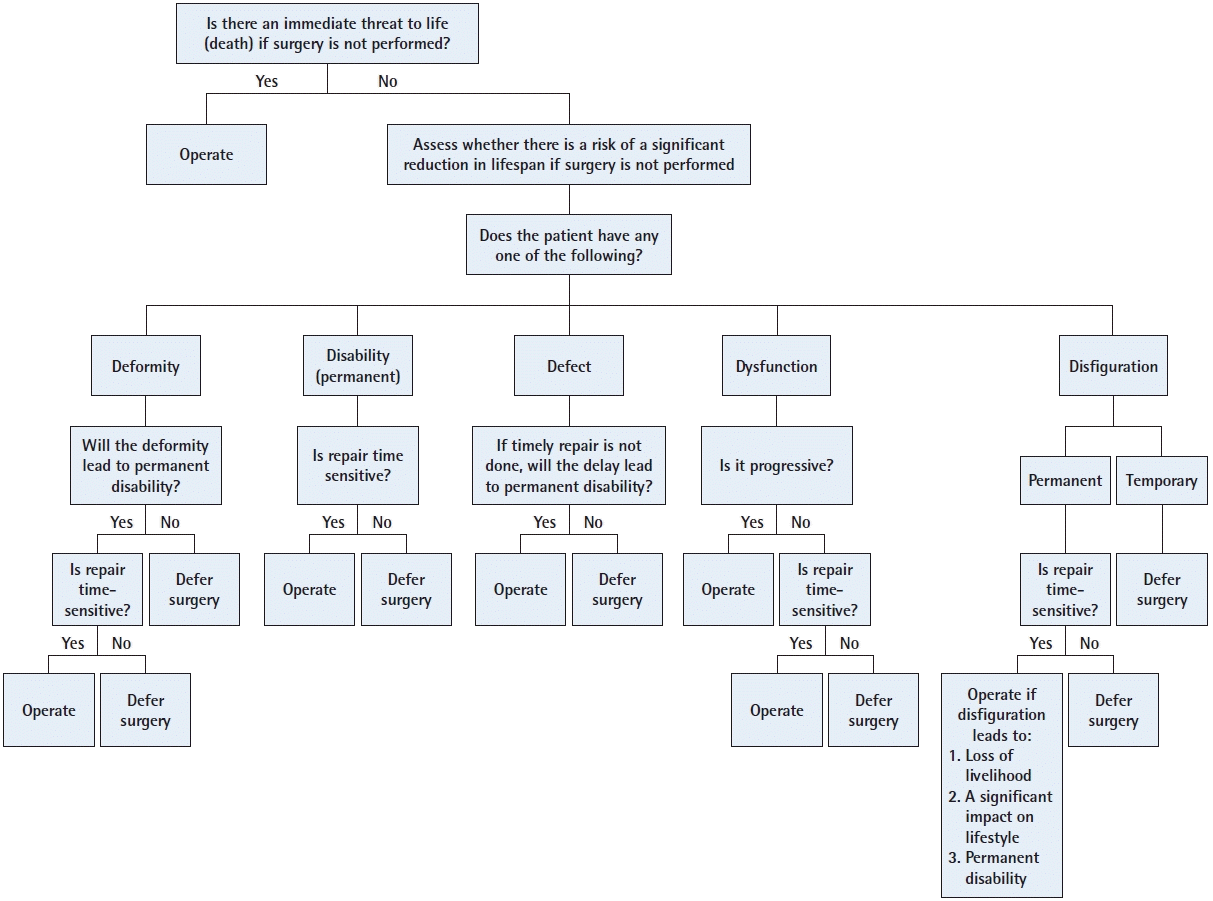The grey zone in plastic surgery: priorities amidst the COVID 19 pandemic
Article information
Introduction
The coronavirus disease 2019 (COVID-19) outbreak originated in Wuhan, China in December 2019. It soon spread beyond China, ravaging other nations, and was declared a pandemic by the World Health Organization (WHO) on March 11, 2020 [1]. The sheer number of COVID-19 cases forced hospitals across the world to make major adjustments in their day-to-day activities. Like all other surgical branches, the COVID-19 pandemic has also affected the specialty of plastic surgery. Following the guidelines given by the American Society of Plastic Surgeons, plastic surgeons in the United States stopped performing elective and non-emergent procedures [2]. Only in a few countries (e.g., England, Ireland, and Sweden) were there no legal restrictions on performing elective plastic surgery procedures [3]. Plastic surgery encompasses a vast array of surgical procedures that cannot be just classified under just two headings, as emergent or non-emergent. There is a third variety of cases that can be classified as “essential”—that is, procedures that cannot be classified as emergency procedures but still cannot be delayed. We present a guideline in this article to identify patients who require such “essential” surgical procedures.
The emergency procedures mentioned in the literature as deserving immediate action include replantation of amputated limbs/digits, reconstruction of defects involving the skull base, third-degree burns and major burns, high-risk malignancies, and fasciotomy for compartment syndrome [4].
Missed procedures
Our literature search did not reveal many other procedures requiring early intervention; examples include tissue expander removal, flap division of local flaps (groin flap, abdominal flap, etc.), ancillary procedures such as arteriovenous fistulas that aid in life-threatening conditions such as chronic kidney diseases, and repair of burst abdomen. Craniofacial syndromes involving complications such as severe exorbitism and airway compromise are some of the many conditions that were not identified as requiring early intervention in our search.
Procedures in the wrong priority category
Procedures such as eyelid reconstruction have sometimes been classified as low-priority procedures, although delays may lead to disastrous complications (e.g., blindness due to prolonged corneal exposure). Similarly, all types of contracture release have been incorrectly deemed as low-priority procedures. For example, severe contractures in the fingers of a school-going child will cause severe functional impairment.
To address these problems, we have devised an algorithm (Fig. 1) in which every case can be individually evaluated and the decision to operate or not can be made. Hence, essential procedures that require urgent intervention can be identified. We have considered the “six D’s” of health, which are the final possible outcomes of any disease/health condition while developing this algorithm.
Death
The first factor to be assessed when evaluating a patient is whether there is a threat to life. Examples include a burn patient with a circumferential eschar on the chest restricting chest movement, causing respiratory compromise, or a patient with maxillofacial trauma with compromised airway. Such patients should be immediately operated upon.
Deformity
A deformity is a condition in which part of the body is not in its normal form or shape. A deformity can be congenital or acquired. In certain conditions, repair is time-sensitive. For example, cleft palate repair should be done before the child reaches 2 years of age; further delay may lead to a higher incidence of speech defects and velopharyngeal insufficiency [5]. In contrast, for some other conditions (e.g., congenital talipes equinovarus) a delay in surgery for a few months will not significantly alter the outcome.
Disability
According to WHO, disability is a blanket term covering activity limitations, impairments, and restrictions in participation [6]. A disability can be temporary or permanent. Permanent disabilities that significantly influence the quality of life (e.g., blindness, which may occur due to eyelid injuries) should be immediately addressed. In contrast, an inability to walk due to tendon injury is a temporary disability, and a delay in surgery will not significantly hamper the patient’s prognosis.
Defect
Defects are breaches in the continuity of tissue. Defects include wounds, ulcers, or raw areas due to trauma, as well as those that occur after resection of malignancies. Reconstruction of small ulcers and wounds in the extremities can be delayed without severe alterations in patients’ quality of life. In contrast, large defects, such as those created in surgical procedures for head and neck cancer, must be immediately reconstructed as they may lead to airway- and nutrition-related complications.
Dysfunction
Dysfunction refers to an impairment or abnormality of function. This category includes sensory/motor/autonomic impairment due to tendon, nerve, bone, muscle, or joint pathology. Nerve injuries such as brachial plexus injuries causing atrophy of the muscles and irreversible damage to the function of the upper limb must be addressed on an urgent basis.
Disfiguration
Disfiguration denotes an aesthetically unacceptable abnormality of the surface that overlies a normal contour. The majority of the conditions in this category require cosmetic corrections, which can be deferred. Exceptions can be made only in certain special conditions where disfigurement causes a loss of livelihood, a significant impact on lifestyle, or permanent disability.
Conclusions
Our guidelines effectively fill the lacunae in the current classification. These guidelines can also be applied in other surgical specialties as well.
In the current circumstances of the COVID-19 pandemic, surgical specialties such as plastic surgery have restricted themselves to only emergency procedures. There is a need to restart the surgical services of plastic surgery, prioritizing cases that cannot be delayed further. However, in the context of the government's preference for uniform restrictions, the proposal of a new category (i.e., essential procedures) will be helpful in preventing delays and will efficiently guide surgeons in deciding whether a particular surgical procedure should be performed or deferred.
Notes
Conflict of interest
No potential conflict of interest relevant to this article was reported.
Author contribution
Conceptualization: all authors. Data curation: M Vathulya. Formal analysis: S Sarabahi. Methodology: M Vathulya, D Nanda, PA Jayaprakash. Project administration: S Sarabahi. Visualization: M Vathulya. Writing - original draft: M Vathulya, PA Jayaprakash. Writing - review & editing: all authors.

